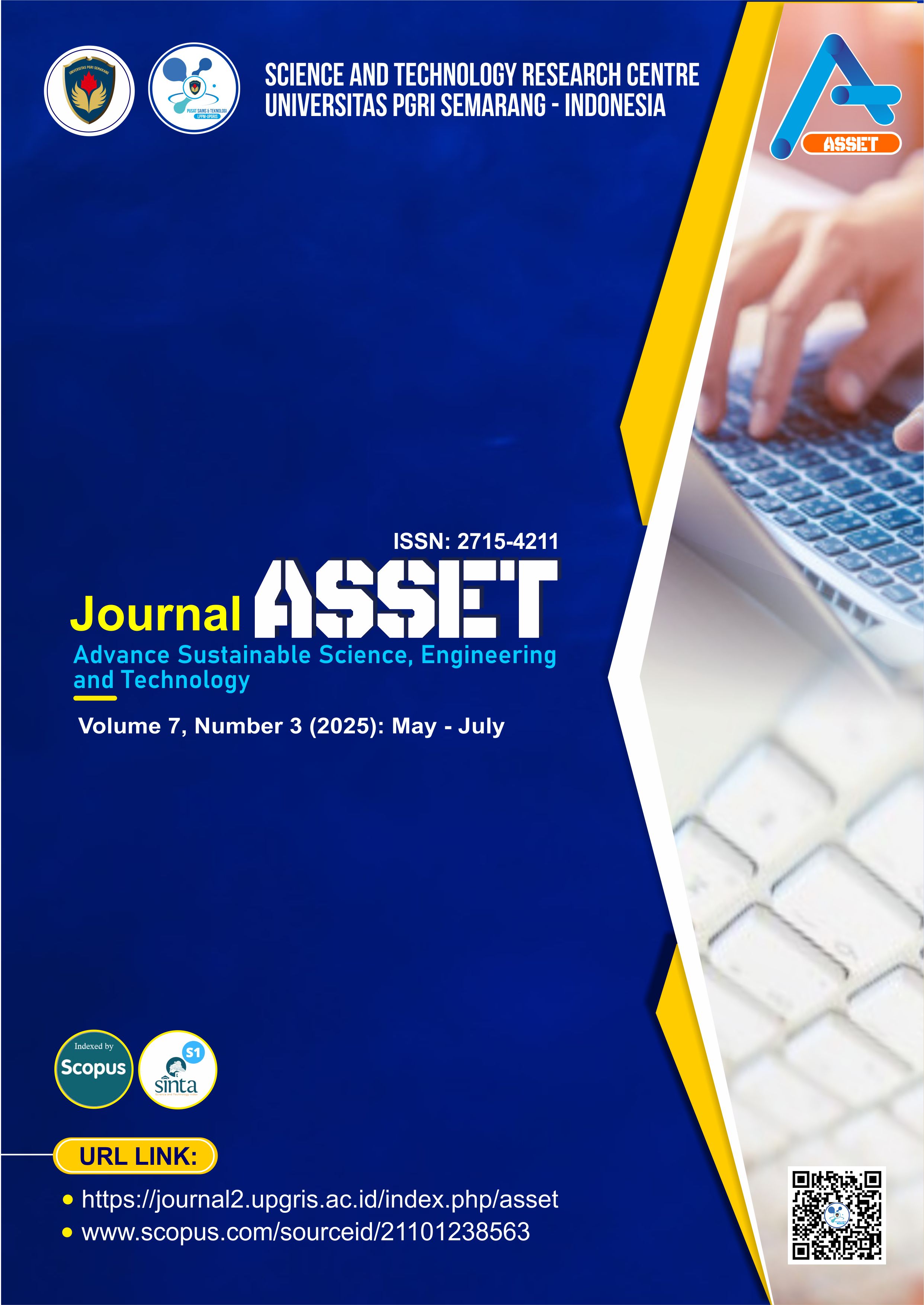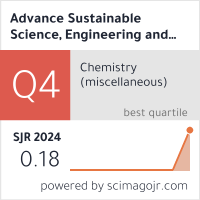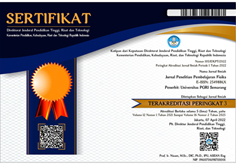Physics-Informed Neural Network with Thevenin Equivalent Circuit for Accurate SOC Li-ion Battery Estimation
DOI:
https://doi.org/10.26877/asset.v7i4.2613Keywords:
battery management systems (BMS), energy storage systems (ESS), equivalent circuit model (ECM), hybrid modeling, state of charge (SOC), uncertainty quantificationAbstract
Accurate state of charge (SOC) estimation is essential for the safety, performance, and longevity of lithium-ion batteries. Physics-based models such as equivalent circuit models (ECMs) are computationally efficient but struggle under nonlinear and time-varying conditions, whereas purely data-driven approaches often lack interpretability. This study proposes a hybrid framework that integrates a physics-informed neural network (PINN) with a first-order Thevenin ECM for dynamic SOC estimation using only terminal voltage and current inputs. The method incorporates physically derived parameters including open-circuit voltage (OCV), polarization resistance, and capacitance identified through pulse testing. An eighth-order OCV–SOC polynomial regression optimized with a genetic algorithm (GA) enables nonlinear mapping, while the Newton–Raphson (NR) method is applied for final SOC estimation. Experimental validation was performed on 18 Ah lithium iron phosphate (LFP) cells over 300 charge–discharge cycles at 20 °C, extended up to 2000 cycles under 1C/2C rates with cut-off voltages of 3.7 V and 2.7 V. Comparative analysis with extended kalman filters (EKF) and standard neural networks (NN) demonstrates the superiority of the proposed method, achieving a root mean squared error (RMSE) of 0.103, mean absolute percentage error (MAPE) of 0.702%, and coefficient of determination (R²) of 0.998. By embedding physical constraints into the learning process, the PINN enhances accuracy, robustness, and generalizability, while reducing estimation uncertainty, thereby offering a scalable and interpretable solution for real-time battery management systems (BMS) in electric vehicles (EVs) and battery energy storage systems (BESS).
References
[1] Adaikkappan A, Maheshwari M, Sathiyamoorthy N. Modeling, state of charge estimation, and charging of lithium-ion battery in electric vehicle: a review. Int J Energy Res 2022;46(3):2141–65. https://doi.org/10.1002/er.7339.
[2] Apribowo CHB, Hadi SP, Wijaya FD, Sarjiya. Optimal sizing and siting of fresh and second-life battery energy storage systems based on linearized optimal power flow for high photovoltaic penetration: A comparative study. Evergreen 2024;11(3):2202–16. https://doi.org/10.5109/7236864.
[3] Apribowo CHB, Sarjiya, Hadi SP, Wijaya FD. Integration of battery energy storage system to increase flexibility and penetration of renewable energy in Indonesia: A brief review. In: Proceedings of the International Conference on Power and Energy. IEEE; 2022. https://doi.org/10.1109/ICPERE56870.2022.10037530.
[4] Tian J, Xiong R, Lu J, Chen C, Shen W. Battery state-of-charge estimation amid dynamic usage with physics-informed deep learning. Energy Storage Mater 2022;50:718–29. https://doi.org/10.1016/j.ensm.2022.12.020.
[5] Xu Z, Wang J, Lund PD, Zhang Y. Co-estimating the state of charge and health of lithium batteries through combining a minimalist electrochemical model and an equivalent circuit model. Energy 2022;240:122815. https://doi.org/10.1016/j.energy.2021.122815.
[6] Gao Y, Liu K, Zhu C, Zhang X, Zhang D. Co-estimation of state-of-charge and state-of-health for lithium-ion batteries using an enhanced electrochemical model. IEEE Trans Ind Electron 2021;69(3):2684–96. https://doi.org/10.1109/TIE.2021.3066946.
[7] Tao Z, Zhao Z, Wang C, Huang L, Jie H, Li H, Hao Q, Zhou Y, See KY. State of charge estimation of lithium batteries: Review for equivalent circuit model methods. Measurement 2024;236:115148. https://doi.org/10.1016/j.measurement.2023.115148.
[8] Thakkar RR. Electrical equivalent circuit models of lithium-ion battery. In: Management and Applications of Energy Storage Devices. IntechOpen; 2021. https://doi.org/10.5772/intechopen.99851.
[9] Salazar D, Garcia M. Estimation and comparison of SOC in batteries used in electromobility using the Thevenin model and coulomb ampere counting. Energies 2022;15(19):7204. https://doi.org/10.3390/en15197204.
[10] Pande AS, Soni BP, Bhadane KV. Electrical models for EV’s batteries: an overview and mathematical design of RC network. J Inst Eng (India) Ser B 2023;104(2):533–47. https://doi.org/10.1007/s40031-022-00852-1.
[11] Apribowo CHB, Hadi SP, Wijaya FD, et al. Optimal sizing and siting of battery energy storage systems with retired battery. In: 2022 International Conference on Technology and Policy in Energy and Electric Power (ICT-PEP). Piscataway (NJ): IEEE; 2022. p. 327–32. https://doi.org/10.1109/ICT-PEP57242.2022.9988958.
[12] Lucaferri V, Quercio M, Laudani A, Riganti Fulginei F. A review on battery model-based and data-driven methods for battery management systems. Energies 2023;16(23):7807. https://doi.org/10.3390/en16237807.
[13] Priya R, Purnima R, Sakile R. State of charge estimation of lithium-ion battery based on extended Kalman filter and unscented Kalman filter techniques. Energy Storage 2023;5(3):e408. https://doi.org/10.1002/est2.408.
[14] Hossain M, Haque ME, Arif MT. Kalman filtering techniques for the online model parameters and state of charge estimation of the Li-ion batteries: A comparative analysis. J Energy Storage 2022;51:104174. https://doi.org/10.1016/j.est.2022.104174.
[15] Zepka R, Bischof S, Blank T. Implementing an extended Kalman filter for SOC estimation of a Li-ion battery with hysteresis: A step-by-step guide. Energies 2021;14(13):3733. https://doi.org/10.3390/en14133733.
[16] Liu X, Qiule L, Li W, Mingqiang L, Ji W. Data-driven state of charge estimation for power battery with improved extended Kalman filter. IEEE Trans Instrum Meas 2023;72:1–10. https://doi.org/10.1109/TIM.2023.3239629.
[17] Zhang S, Chen Z, Shiyong J, Xiongwen Z. A comparative study of different adaptive extended/unscented Kalman filters for lithium-ion battery state-of-charge estimation. Energy 2022;246:123423. https://doi.org/10.1016/j.energy.2022.123423.
[18] Hossain M, Enamul HMD, Arif MT. Online model parameter and state of charge estimation of Li-ion battery using unscented Kalman filter considering effects of temperatures and C-rates. IEEE Trans Energy Convers 2022;37(4):2498–511. https://doi.org/10.1109/TEC.2022.3178600.
[19] Wang S, Jia X, Takyi-Aninakwa P, Stroe DI, Fernandez C. Optimized particle filtering strategies for high-accuracy state of charge estimation of LIBs. J Electrochem Soc 2023;170(5):050514. https://doi.org/10.1149/1945-7111/acd148.
[20] Zhang C, Zhao H, Wang L, Liao C, Wang L. A comparative study on state-of-charge estimation for lithium-rich manganese-based battery based on Bayesian filtering and machine learning methods. Energy 2024;306:132349. https://doi.org/10.1016/j.energy.2024.132349.
[21] Sesidhar DVSR, Badachi C, Green RC. A review on data-driven SOC estimation with Li-ion batteries: Implementation methods and future aspirations. J Energy Storage 2023;72:108420. https://doi.org/10.1016/j.est.2023.108420.
[22] Lipu MH, Hannan MA, Aini H, Shaheer A, Rahman SA, Mohamad HM, Kashem MM. Real-time state of charge estimation of lithium-ion batteries using optimized random forest regression algorithm. IEEE Trans Intell Veh 2022;8(1):639–48. https://doi.org/10.1109/TIV.2022.3161301.
[23] Jafari S, Yang JH, Byun YC. Optimized XGBoost modeling for accurate battery capacity degradation prediction. Results Eng 2024;24:102786. https://doi.org/10.1016/j.rineng.2024.102786.
[24] Tian J, Chen C, Shen W, Sun F, Xiong R. Deep learning framework for lithium-ion battery state of charge estimation: Recent advances and future perspectives. Energy Storage Mater 2023;61:102883. https://doi.org/10.1016/j.ensm.2023.102883.
[25] Guo S, Ma L. A comparative study of different deep learning algorithms for lithium-ion batteries on state-of-charge estimation. Energy 2023;263:125872. https://doi.org/10.1016/j.energy.2022.125872.
[26] Fan X, Zhang W, Zhang C, Chen A, An F. SOC estimation of Li-ion battery using convolutional neural network with U-Net architecture. Energy 2022;256:124612. https://doi.org/10.1016/j.energy.2022.124612.
[27] Chen J, Zhang Y, Wu J, Cheng W, Zhu Q. SOC estimation for lithium-ion battery using the LSTM-RNN with extended input and constrained output. Energy 2023;262:125375. https://doi.org/10.1016/j.energy.2022.125375.
[28] Zhao Y, Li Y, Cao Y, Jiang L, Wan J, Rehtanz C. An RNN with small sequence trained by multi-level optimization for SOC estimation in Li-ion battery applications. IEEE Trans Veh Technol 2023;72(9):11469–81. https://doi.org/10.1109/TVT.2023.3267500.
[29] Cui Z, Wang L, Li Q, Wang K. A comprehensive review on the state of charge estimation for lithium-ion battery based on neural network. Int J Energy Res 2022;46(5):5423–40. https://doi.org/10.1002/er.7545.
[30] Chai X, Shihao L, Liang F. A novel battery SOC estimation method based on random search optimized LSTM neural network. Energy 2024;306:132583. https://doi.org/10.1016/j.energy.2024.132583.
[31] Wu Y, Bai D, Zhang K, Li Y, Yang F. Advancements in the estimation of the state of charge of lithium-ion battery: A comprehensive review of traditional and deep learning approaches. J Mater Inform 2025;5(2). https://doi.org/10.20517/jmi.2024.84.
[32] Yi Y, Xia C, Shi L, Meng L, Chi Q, Qian L, Ma T, Chen S. Lithium-ion battery expansion mechanism and Gaussian process regression based state of charge estimation with expansion characteristics. Energy 2024;292:130541. https://doi.org/10.1016/j.energy.2024.130541.
[33] Apribowo CH, Dyartanti ER, Al Farisi S, Hafidzsyah H. Design and development of battery cell protection system on LFP battery pack using bypass techniques. In: 2023 International Conference on Technology and Policy in Energy and Electric Power (ICT-PEP). IEEE; 2023. p. 316–21. https://doi.org/10.1109/ICT-PEP60152.2023.10351176.
[34] Mehta C, Sant AV, Sharma P. SVM-assisted ANN model with principal component analysis based dimensionality reduction for enhancing state-of-charge estimation in LiFePO4 batteries. e-Prime Adv Electr Eng Electron Energy 2024;8:100596. https://doi.org/10.1016/j.prime.2024.10059.
[35] Zhang G, Xia B, Wang J, Ye B, Chen Y, Yu Z, Li Y. Intelligent state of charge estimation of battery pack based on particle swarm optimization algorithm improved radial basis function neural network. J Energy Storage 2022;50:104211. https://doi.org/10.1016/j.est.2022.104211.
[36] Singh S, Ebongue YE, Rezaei S, Birke KP. Hybrid modeling of lithium-ion battery: Physics-informed neural network for battery state estimation. Batteries 2023;9(6):301. https://doi.org/10.3390/batteries9060301.
[37] Navidi S, Thelen A, Li T, Hu C. Physics-informed machine learning for battery degradation diagnostics: A comparison of state-of-the-art methods. Energy Storage Mater 2024;68:103343. https://doi.org/10.1016/j.ensm.2024.103343.
[38] Dezhi S, Ding J, Hao T. Elman neural network and Thevenin equivalent circuit model based multi-measurement Kalman filter for SOC estimation. Ionics 2024;30(2):833–45. https://doi.org/10.1007/s11581-023-05307-1.
[39] Wang Q, Min Y, Bin L, Gaoqi L, Yan L. Co-estimation of state of charge and capacity for battery packs in real electric vehicles with few representative cells and physics-informed machine learning. Energy 2024;306:132520. https://doi.org/10.1016/j.energy.2024.132520.
[40] Su S, Wei L, Jianhui M, Akhil G, Liang G, Jie L. A hybrid battery equivalent circuit model, deep learning, and transfer learning for battery state monitoring. IEEE Trans Transp Electrif 2022;9(1):1113–27. https://doi.org/10.1109/TTE.2022.3204843.
[41] Dang L, Yang J, Liu M, Chen. Differential equation-informed neural network for state-of-charge estimation. IEEE Trans Instrum Meas 2023;73:1–5. https://doi.org/10.1109/TIM.2023.3334377.
[42] Gao Y, Plett GL, Fan G, Zhang X. Enhanced state-of-charge estimation of LiFePO4 batteries using an augmented physics-based model. J Power Sources 2022;544:231889. https://doi.org/10.1016/j.jpowsour.2022.231889.











